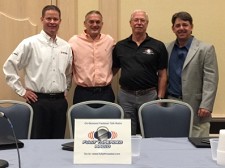7/6/2015
HEADLINES
Fastener Tech Panelists Point Out Industry Trends
(l-r) Peplinski, Baer, Musker and Dudas (photo credit Larry Kelly)
Three “Industry Trends” panelists at Fastener Tech ’15 predicted a variety of changes coming to the fastener industry in coming years.
Bob Baer, vice president of Abbott-Interfast Corp., predicts fastener making machinery will advance beyond humans programming what machines will produce.
“Instead of us telling machines, machinery will be telling us what needs to be produced,” Baer told the Fastener Tech conference.
Baer also predicted lighter weight fasteners from stronger materials; more plastic fasteners, and “better, longer-lasting coatings.”
Ultimately, some engineer will find an end for hydrogen embrittlement, Baer predicted.
Baer suggested another possibility: Someone may invent a compromise between inch and metric.
One reason for advances in fastener engineering: “A rash of engineering graduates” who may create a third industrial revolution.
• More and more ordering will be online, Baer said. Fastener distributors need to provide online ordering or customers “will look elsewhere.”
Even Amazon will be selling fastener specials, he added.
The future may include parts on demand in OEM facilities with 3-D printing, Baer added.
• Fastener warehouses must be more automated. Advancements will allow even small package quantities, Baer said.
• Reshoring is up, but more specials going overseas will still hurt U.S. manufacturing, Baer observed.
• U.S. capital improvements will “surge,” Baer predicted.
• If Republicans win the White House in 2016, military spending will increase.
While the auto industry is currently strong, will driverless cars mean fewer new cars? Baer asked. He cited an Ann Arbor, MI experiment where a family owns one car which drops off the parent at work and then returns to house to take children to school.
But today the auto industry is doing well with price of cars up as consumers are buying more gadgets.
Musker: Driverless Delivery Trucks?
What is coming to the fastener industry was “science fiction” just a few years ago, Brian Musker of FastenersClearingHouse told conference attendees.
Musker recalled demonstrating early versions of the Internet 20 years ago and predicting it would grow. “No one believed me.”
The distribution industry is going to change radically, Musker predicted. “There will be new channels,” He cited cheaper ordering, direct delivery systems, drones, and driverless delivery trucks as examples of what is to come.
• Musker noted the industry came off a difficult three months due to West Coast ports’ labor slowdown (see FIN, February 17, 2015 and April 27, 2015), a “brutal winter slowing down construction,” and “shakiness of the Euro due to Greece.” Now the industry “is hesitant and not confident about coming months,” Musker observed. “We are in a ‘wait & see’ mood.”
• The U.S. is still the major player in the world economy, Musker said. He cited the size of the ExxonMobil’s suburban Houston corporate complex which tops 10,000 employees, as demonstration of the U.S. economy. It shows the growth in Texas vs. Chicago, he added.
• Amazon is processing 80,000 orders a minute, he noted. “The numbers are staggering. The rates are going to accelerate.”
He urged the fastener industry to have “more than a catalog online.”
• Ultimately, get ready for more change than you can dream of: “The refrigerator is going to tell us what food needs to be ordered,” Musker said. “Tighten your seat belts.”
Peplinski: Have Succession Plan for Suppliers
Joe Peplinski of Würth Industry North America, predicted fastener production will continue to move “county to country to meet lower cost pressures from OEMs.”
North American is accustomed to production of standards moving to Asia, but even high-grade fasteners will moved from traditional fastener manufacturing locations to emerging manufacturing nations in the coming years, Peplinski predicted.
Peplinski cautioned distributors of “always buying cheap cost.” The result can be sample parts “clearly not meeting standards,” he warned. “That creates a fastener industry problem we are dancing around.”
“Know your supplier,” Peplinski advised distributors. “Understand your supplier.”
He advised distributors to have “succession plans for suppliers. Know your supplier. Understand your supplier. Have you visited? How often have you visited? Is your supplier moving forward with investments in added technology?”
“The risk is too great,” Peplinski said in pointing to bankruptcies of major suppliers, especially in Europe.
• One part of the fastener industry that hasn’t changed with the times is the warehouse. “There are very, very few warehouses in the fastener industry which look different from 25 years ago,” Peplinski observed. “That’s not sustainable. It is living in the past.”
The average fastener warehouse should have been more automated a decade ago, Peplinski suggested.
The U.S. industry needs to “remove people from the process,” just as new technology is allowing in Europe. The fastener industry “has to change for profit.”
• Taiwan has an advantage as a fastener supplier because the steel producers are the “most stable and predictable.”
He predicted recent steel price reductions “will hold for the foreseeable future.” But that can be difficult for fastener companies with high-priced inventory on shelves, Peplinski pointed out.
• Mainland China’s fastener production rates have slowed. There is concern about China’s “fragile economy” and corrupt companies where owners pocket government incentives.
“Chinese fastener producers are trying to move up to specials,” Peplinski finds.
The Industry Trends program was sponsored by FCH Sourcing Network.
Related Stories:
• Fastener Tech Booth Count Up for 2015
• Stanley Black & Decker Sees Organic Fastener Growth


Share: